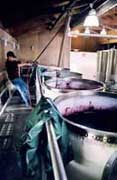History of Barrels
In the 13th.century B.C. peoples from the Balkans and regions north of the Danube arrived in the area known today as Burgundy. They were the Celts, technicians who worked with clay, wood, iron and precious metals. They were also the inventors of the vault keystone. (The Roman construction was made of piled stone) The Celts from Gaul were called The Gaulois (or Gauls). Their language was Gaelic. In Gaul there were bread ovens, heating ducts, cellars and church vaults. They kept their wine in earthenware pots. The Gauls, however, did not leave written traces. Their writing was made in wax or fat tablets which were easily destroyed at the sight of an enemy.
It is believed that after hollowing out tree trunks to make boats, man considered bending planks to build the hulls of boats, so the shaping of woody materials into curves by heating was discovered.
As of 900 years B.C., the Greeks came in ships loaded with sacks of barley, wheat and building materials.In approximately 600 B.C. they founded Marseille where they brought vines and olive trees.
At around 350 B.C. the Celts elaborated rounded watertight recipients that were able to withstand stress (from rolling) and weight (from stacking). This is the barrel (tonneau) - from the Latin name "Dolium" meaning rounded. Ever since that time the barrel has been manufactured using basically the same techniques. The Gallic measure of a barrel contained about 1000 litres. After serving as a recipient for transporting liquids, it served for the transport of precious metals, powders, ochre, sulphur, etc. It was also used to hold fish, olives, jam, mustard, vinegar and pickled foods.
Columelle and Pliney spoke to us of a large earthenware vase called a Cadus, in which wine was kept. The Romans manufactured small wooden vats, called Culei. In 51 B.C. during the siege of Uxellodenum (today called Vayrac, in the Lot) historians note the use of barrels as a means of defence. They were filled with inflammable materials and were named Cupae by Caesar.
Diodore, a contemporary of Caesar, wrote in Sicily: "The Italian merchants exploit the Gallic passion for wine. On the boats which follow the waterways or by wagons which roll across the plain, they transport wine, from which they make fantastic profits, going as far as trading one amphora for one slave, in such manner that the buyer brings his servant to pay for the drink."
As of 70 A.D., under Tiberius and Vespasien, the barrel became known as Cupa (vat) but the Latin name Dolium also designated the barrel. The Romans also called the large earthenware vases Dolia. Towards the end of the era of Augustus, beyond the Cvennes, the Allobroges of the Vienne region in the Rhone valley selected a vine species that was acclimatised to their region. This "Allobrogic" variety bore grapes and was resistant to frost. Thus pushing back the northern limits of vine cultivation by some hundreds of kilometres. At the same time in the plains of Aquitaine, in the Gaillac region, another vine variety "Biturica" made Bordeaux prosper. Traffic toward England and Ireland was established from here.
The progression of the vine worried the Romans; the Gallic wine was much appreciated in Rome. In 92 A.D., in an early example of protectionism, the emperor Domitien decided to destroy the Gallic vineyards which had become a major force in wine production. Around the same time Pline the Elder noted the appearance, in the regions near the Alps, of an exceptional recipient specially conceived to hold wine: the wooden barrel. It was used in the colder countries, while elsewhere wine was stored in earthenware vases. The barrel became inseparably associated with wine, from its fermentation to its transport. In the regions where cellars were built it was easy to stock barrels. In archaeological research has found coopers tools and wooden seals dating from 100 B.C.
Up until the First World War the cooper looked after the wine cellar. He watched over the fermentation and cared for the wine. After the war, the vintner replaced the cooper and started looking after the cellar himself. Then there was a spread of replacement of wood by more modern recipients. Little by little wine was more commonly drawn-off into bottles rather than barrels which no longer had the same popularity.
At the risk of upsetting followers of cement, steel or plastic, it must be stated that wood is indispensable to the conservation and ageing of wine and spirits. The carbon dioxide and volatile ethers that cloak the aroma of the wine evaporate through the wood. A real transformation of the wine and spirits is seen.
Slow oxidation, allowed by the porosity of the wood, helps the wine lose its astringency and harshness giving softness and suppleness instead. Red wines take on a warmer colour and lose their purple-blueness. White wines are richer-coloured. Spirits take on that beautiful golden colouring and a soft taste of amber. Here you have the Gallic breakthrough.
Around the 1950's American winegrowers discovered French barrels. And from then on all the wine producing countries looked to improving the quality of their wine by keeping it in French oak. In 1977 a study group was formed to make a series of experiments on the ageing of Burgundy wines in new oak barrels.
If you want to comment on this or any other pages on this site please use the Cellar Room. If your category isn't listed, make one up.
Last update May 2024. Santa Barbara.
The current local time is 07:33:45 pm
:: Content ©2006 admin@sbwinemakers.com ::
:: Videography ©2006 admin@sbwinemakers.com ::


